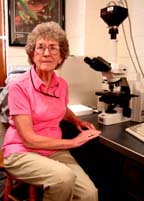Marilyn R. N. Mollicone
Marilyn Rose Noyes grew up on a farm in Bethel, Maine and learned the beginnings of natural history from her mother and father. While still in grade school, a program of color slides of native flowers by a local woman photographer inspired her lifelong passion for botany. She attended Gould Academy in Bethel, Maine and graduated in 1946, second in her class. Marilyn attended the University of Maine where she was the only woman in most of her classes in the College of Agriculture. She graduated in 1950 with a B.S. in Botany, with High Distinction. Later in 1950, Marilyn married Phillip Mollicone and soon gave up her studies to start a family. While her son and daughter were teenagers, she began a career as a naturalist as the director of a natural history day camp program for children held at the Augusta Nature Center, Augusta, Maine, where she remained the director for 19 years. Marilyn’s husband, Phillip, died in 1978. Eight years later, in 1986, at the age of 58, Marilyn returned to the University of Maine where her mentor was Dr. Joyce Longcore, student of chytrids. She chose to study the Order Monoblepharidales when she found a member of the order in her first sample from nature, collected among cattails growing in a shallow pond in an old quarry in Augusta Nature Center. Marilyn received her Master of Science in Botany and Plant Pathology in 1993. Her thesis was entitled “Life Cycle, Morphology, Culture, and Zoosporic Ultrastructure of Monoblepharis polymorpha”. Her initial Ph.D. research focused on the ultrastructure of Gonapodya polymorpha, which was published as “Zoospore ultrastructure of Gonapodya polymorpha” in the Journal Mycologia in 1999. She isolated and grew pure cultures of several genera of Monoblepharidales, studied details of their development and photographed many specimens of the order. Unable to continue her Ph.D. work because of health issues, she concentrated on preparing directions to enable others to obtain and use members of the Monoblepharidales for teaching and research.

